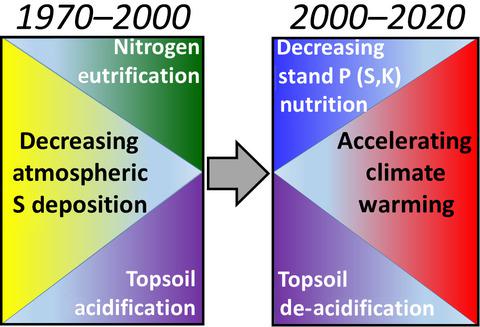当前位置:
X-MOL 学术
›
Glob. Change Biol.
›
论文详情
Our official English website, www.x-mol.net, welcomes your
feedback! (Note: you will need to create a separate account there.)
Half a century of Scots pine forest ecosystem monitoring reveals long-term effects of atmospheric deposition and climate change.
Global Change Biology ( IF 10.8 ) Pub Date : 2020-07-09 , DOI: 10.1111/gcb.15265 Jörg Prietzel 1 , Wolfgang Falk 2 , Birgit Reger 2, 3, 4 , Enno Uhl 2, 3 , Hans Pretzsch 3 , Lothar Zimmermann 2
Global Change Biology ( IF 10.8 ) Pub Date : 2020-07-09 , DOI: 10.1111/gcb.15265 Jörg Prietzel 1 , Wolfgang Falk 2 , Birgit Reger 2, 3, 4 , Enno Uhl 2, 3 , Hans Pretzsch 3 , Lothar Zimmermann 2
Affiliation

|
At two forest sites in Germany (Pfaffenwinkel, Pustert) stocked with mature Scots pine (Pinus sylvestris L.), we investigated changes of topsoil chemistry during the recent 40 years by soil inventories conducted on replicated control plots of fertilization experiments, allowing a statistical analysis. Additionally, we monitored the nutritional status of both stands from 1964 until 2019 and quantified stand growth during the monitoring period by repeated stand inventories. Moreover, we monitored climate variables (air temperature and precipitation) and calculated annual climatic water balances from 1991 to 2019. Atmospheric nitrogen (N) and sulfur (S) deposition between 1964 and 2019 was estimated for the period 1969–2019 by combining annual deposition measurements conducted in 1985–1987 and 2004 with long‐term deposition records from long‐term forest monitoring stations. We investigated interrelations between topsoil chemistry, stand nutrition, stand growth, deposition, and climate trends. At both sites, the onset of the new millennium was a turning point of important biogeochemical processes. Topsoil acidification turned into re‐alkalinization, soil organic matter (SOM) accumulation stopped, and likely turned into SOM depletion. In the new millennium, topsoil stocks of S and plant‐available phosphorus (P) as well as S and P concentrations in Scots pine foliage decreased substantially; yet, age‐referenced stand growth remained at levels far above those expected from yield table data. Tree P and S nutrition as well as climate change (increased temperature and drought stress) have replaced soil acidification as major future challenges for both forests. Understanding of P and S cycling and water fluxes in forest ecosystems, and consideration of these issues in forest management is important for successfully tackling the new challenges. Our study illustrates the importance of long‐term forest monitoring to identify slow, but substantial changes of forest biogeochemistry driven by natural and anthropogenic global change.
中文翻译:

半个世纪的苏格兰松树林生态系统监测揭示了大气沉积和气候变化的长期影响。
在德国的两个森林站点(Pfaffenwinkel,Pustert),放有成熟的苏格兰松树(Pinus sylvestris)L.),我们调查了最近40年间通过在施肥实验的重复对照样地上进行的土壤清查对表土化学的变化,从而进行了统计分析。此外,我们监测了从1964年到2019年这两种林分的营养状况,并通过重复进行林分库存量化了监测期间的林分生长。此外,我们监测了气候变量(气温和降水)并计算了1991年至2019年的年度气候水平衡。通过结合年度沉积量,估算了1969-2019年期间1964-2019年的大气氮(N)和硫(S)沉积量1985-1987年和2004年进行了测量,并获得了长期森林监测站的长期沉积记录。我们调查了表土化学,林分营养,反映生长,沉积和气候趋势。在这两个地点,新千年的开始是重要的生物地球化学过程的转折点。表土酸化变成重新碱化,土壤有机质(SOM)的积累停止,并有可能变成SOM耗尽。在新的千年中,苏格兰松树叶子中的S和植物有效磷(P)的表层土壤储量以及S和P的浓度显着下降。然而,以年龄为基准的林分增长仍远高于产量表数据预期的水平。树木P和S的营养以及气候变化(温度升高和干旱胁迫)已取代土壤酸化,成为这两种森林未来面临的主要挑战。了解森林生态系统中的磷和硫循环以及水通量,在森林管理中考虑这些问题对于成功应对新挑战至关重要。我们的研究表明,长期森林监测对于识别由自然和人为全球变化驱动的森林生物地球化学缓慢但实质性变化的重要性。
更新日期:2020-07-09
中文翻译:

半个世纪的苏格兰松树林生态系统监测揭示了大气沉积和气候变化的长期影响。
在德国的两个森林站点(Pfaffenwinkel,Pustert),放有成熟的苏格兰松树(Pinus sylvestris)L.),我们调查了最近40年间通过在施肥实验的重复对照样地上进行的土壤清查对表土化学的变化,从而进行了统计分析。此外,我们监测了从1964年到2019年这两种林分的营养状况,并通过重复进行林分库存量化了监测期间的林分生长。此外,我们监测了气候变量(气温和降水)并计算了1991年至2019年的年度气候水平衡。通过结合年度沉积量,估算了1969-2019年期间1964-2019年的大气氮(N)和硫(S)沉积量1985-1987年和2004年进行了测量,并获得了长期森林监测站的长期沉积记录。我们调查了表土化学,林分营养,反映生长,沉积和气候趋势。在这两个地点,新千年的开始是重要的生物地球化学过程的转折点。表土酸化变成重新碱化,土壤有机质(SOM)的积累停止,并有可能变成SOM耗尽。在新的千年中,苏格兰松树叶子中的S和植物有效磷(P)的表层土壤储量以及S和P的浓度显着下降。然而,以年龄为基准的林分增长仍远高于产量表数据预期的水平。树木P和S的营养以及气候变化(温度升高和干旱胁迫)已取代土壤酸化,成为这两种森林未来面临的主要挑战。了解森林生态系统中的磷和硫循环以及水通量,在森林管理中考虑这些问题对于成功应对新挑战至关重要。我们的研究表明,长期森林监测对于识别由自然和人为全球变化驱动的森林生物地球化学缓慢但实质性变化的重要性。











































 京公网安备 11010802027423号
京公网安备 11010802027423号